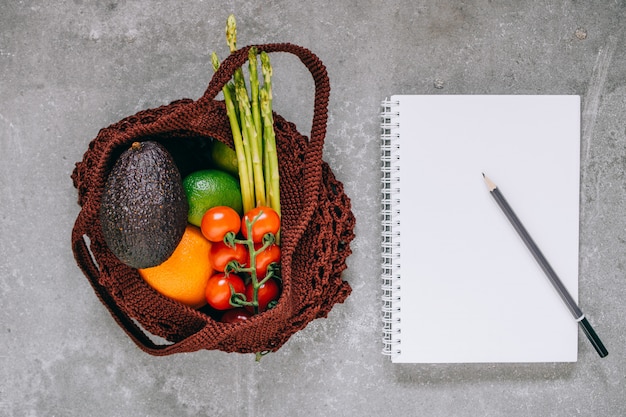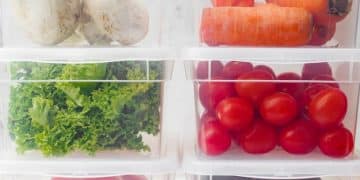Grocery Savings Challenge: Save $1000 in 6 Months?

Embarking on a Grocery Savings Challenge: Can You Save $1000 on Groceries in 6 Months? is a realistic financial goal achievable through strategic planning, smart shopping habits, and consistent effort to reduce food expenditures effectively.
Are you ready to transform your grocery budget and put an extra $1000 back into your pocket? The concept of a Grocery Savings Challenge: Can You Save $1000 on Groceries in 6 Months? might sound daunting at first, yet it’s an incredibly achievable goal with the right strategies and a committed mindset. This isn’t just about cutting costs; it’s about making smarter choices that benefit both your wallet and your household’s well-being.
Understanding the $1000 in 6 Months Challenge
The idea behind saving $1000 on groceries over a six-month period involves more than just clipping coupons. It requires a holistic approach to how you plan, shop, cook, and even store your food. This challenge encourages a deep dive into your current spending habits to identify areas where significant reductions can be made without sacrificing nutrition or enjoyment.
To truly understand the scope of this challenge, consider your average monthly grocery bill. If you spend $500 a month, saving $1000 over six months means you need to reduce your spending by approximately $167 per month. While this might seem like a considerable amount, breaking it down into smaller, manageable weekly or daily targets makes the goal far less intimidating. It’s about consistent, small adjustments that accumulate into substantial savings.
Setting Realistic Expectations and Goals
Before diving into specific tactics, it’s crucial to set realistic expectations. Not every family’s grocery budget will allow for the same level of savings, given varying household sizes, dietary needs, and geographical locations. However, the principles remain universal. Begin by tracking your current grocery expenses for at least a month to establish a baseline. This data is invaluable for understanding where your money is currently going.
- Track Every Dollar: Document every grocery purchase, from your big weekly haul to quick convenience store stops.
- Analyze Spending Patterns: Identify categories where you overspend, such as impulse buys, pre-packaged meals, or excessive meat purchases.
- Set Specific Targets: Break down the $1000 goal into monthly or weekly savings targets. For example, aiming to save $40-$45 per week.
This initial period of self-assessment is fundamental. It transforms an abstract goal into a concrete plan, allowing you to tailor strategies that specifically address your household’s unique spending habits. Remember, the journey towards saving $1000 is a marathon, not a sprint, and consistency is your most powerful ally.
Ultimately, the challenge is an opportunity to cultivate a more mindful relationship with your food and finances. It’s about becoming a more astute consumer, one prepared to make informed decisions that serve your long-term financial health. The process often reveals surprising insights into how small daily choices impact the larger budget.

Mastering the Art of Meal Planning
Effective meal planning is arguably the cornerstone of any successful grocery savings strategy. It transcends simply deciding what to eat; it’s a comprehensive process that minimizes waste, maximizes ingredients, and curtails impulse purchases. Without a solid plan, you’re more susceptible to buying unnecessary items or opting for expensive last-minute solutions.
Begin by assessing your pantry and refrigerator contents. What ingredients do you already have that can be incorporated into upcoming meals? This “inventory first” approach reduces the need to buy duplicate items and ensures that food doesn’t go to waste. Next, consider your family’s schedule and dietary preferences. A plan that fits your lifestyle is more likely to be sustained.
Strategic Approaches to Meal Planning
When crafting your weekly or bi-weekly meal plan, think about versatility and efficiency. Can ingredients be used in multiple dishes? For instance, roasted chicken can be dinner one night, and leftover chicken can be used for salads or sandwiches the next. This concept of “cook once, eat twice” is a powerful money-saving tool.
- Theme Nights: Designate specific nights for certain types of meals (e.g., Meatless Monday, Taco Tuesday, Pasta Thursday) to streamline planning.
- Utilize Sale Items: Plan meals around what’s on sale at your local grocery store. Check flyers and apps before planning to incorporate discounted items.
- Batch Cooking: Prepare large quantities of staples like grains, cooked proteins, or roasted vegetables to use throughout the week.
Incorporating these elements into your meal planning reduces decision fatigue and makes grocery shopping a targeted mission rather than a random stroll through aisles. It fosters a proactive approach, where you are dictating your consumption rather than reacting to hunger or convenience.
Beyond saving money, meal planning also contributes to healthier eating habits by encouraging home-cooked meals and reducing reliance on takeout. This intentional approach to food consumption can have significant long-term benefits for both your physical and financial well-being. It’s an investment in your lifestyle.
Smart Shopping: Beyond Just Coupons
While coupons certainly have their place in the realm of grocery savings, smart shopping encompasses a much broader array of tactics designed to optimize every purchase. It’s about making conscious decisions before, during, and after your trip to the store, ensuring every dollar spent is deliberate and efficient.
One of the most effective strategies is to avoid shopping when hungry. Studies show that people tend to buy more impulse items and higher-calorie, less healthy foods when their stomachs are rumbling. A quick snack before heading to the store can make a surprising difference in your cart’s contents and your final bill.
Key Practices for Optimized Shopping
The “perimeter shopping” rule is another valuable tip: most grocery stores stock fresh produce, dairy, and lean proteins around the outer edges of the store. The inner aisles are typically filled with highly processed, often more expensive, packaged goods. Sticking to the perimeter helps you focus on healthier, whole foods that are often more economical per serving.
- Price Comparisons: Don’t assume one store is always cheaper. Use apps or keep a mental note of prices for your most frequently purchased items across different retailers.
- Generic vs. Brand Name: Often, store-brand items are produced in the same factories as their brand-name counterparts but sold at a significantly lower price. Give them a try!
- Shop in Season: Produce that is in season is typically more abundant, fresher, and cheaper. Plan meals around seasonal fruits and vegetables.
Bulk buying can be a double-edged sword. While it often offers a lower unit price, it only saves money if you actually consume the entire amount before it spoils. Assess your consumption rate for non-perishable items like pasta, rice, or canned goods, and perishable items like certain produce, before committing to large quantities.
Furthermore, staying organized with your shopping list is paramount. A well-organized list, ideally categorized by store section, can save you time and prevent unnecessary detours through tempting aisles. This structured approach to shopping is a crucial element of the overall savings challenge.
Reducing Food Waste: Every Scraps Counts
Food waste is not just an environmental concern; it’s a significant drain on your grocery budget. Throwing away spoiled produce, uneaten leftovers, or expired pantry items is akin to throwing money directly into the trash. In the pursuit of saving $1000, minimizing food waste becomes an essential component.
One common culprit for food waste is overbuying. The allure of bulk deals can sometimes lead to purchasing more than you realistically need or can consume. Before buying large quantities, consider your household’s consumption habits and the shelf life of the product. It’s better to make an extra trip to the store than to discard unused food.
Innovative Ways to Minimize Waste
Effective food storage is key to extending the life of your groceries. Understanding how to properly store fruits, vegetables, and other perishables can prevent premature spoilage. For example, keeping apples away from other produce, or storing herbs in water, can significantly prolong their freshness.
- First In, First Out (FIFO): Rotate your pantry and refrigerator items so that older items are used first.
- Creative Leftover Use: Repurpose leftovers into new meals. A leftover stir-fry can become a filling for spring rolls, or roasted vegetables can be added to an omelet.
- Freezing: Become adept at freezing. Excess produce, cooked portions, or even bread can be frozen for later use, saving them from spoiling.
Beyond individual efforts, composting food scraps can also contribute to a more sustainable household, even if it doesn’t directly save money on groceries. It closes the loop on food consumption, turning what would be waste into a valuable resource for gardening.
The goal is to cultivate a mindset where every piece of food is valued and utilized to its fullest extent. This intentional approach not only shrinks your grocery bill but also fosters a deeper appreciation for the resources involved in food production.
Utilizing Technology and Loyalty Programs
In the digital age, a wealth of tools and programs exist to assist you in your grocery savings journey. From sophisticated budgeting apps to personalized loyalty discounts, leveraging technology can significantly enhance your ability to reach that $1000 savings goal within six months.
Many grocery store chains offer loyalty programs that provide members with exclusive discounts, personalized coupons based on past purchases, and sometimes even fuel rewards. Signing up for these programs is usually free and can lead to substantial savings over time, as offers are often tailored to items you regularly buy.
Leveraging Digital Tools for Maximum Savings
Grocery comparison apps allow you to quickly check prices across different stores, ensuring you’re getting the best deal on specific items. Some apps even track price history, indicating whether a “sale” price is genuinely a good deal or a recurring promotion. This real-time information empowers you to make informed decisions before heading out.
- Coupon Apps: Beyond traditional paper coupons, many apps offer digital coupons that can be loaded directly onto your loyalty card.
- Cash-Back Apps: Several apps provide cash back on grocery purchases, often for specific brands or categories. This can add up to significant savings over six months.
- Budgeting Software: Use budgeting apps to track your grocery spending against your set budget, providing clear insights into your progress towards the $1000 goal.
Social media groups and online forums dedicated to grocery savings can also be a valuable resource. Members often share tips, identify the best deals in their local area, and discuss effective strategies for cutting costs. This community aspect adds a layer of shared knowledge and motivation.
However, a word of caution: don’t let the pursuit of coupons or loyalty points lead you to buy items you don’t need simply because they’re “on sale.” True savings come from buying only what you’ll use, at the best possible price. Technology is a tool to support your plan, not to dictate your purchases.
Beyond the Supermarket: Alternative Shopping Options
While mainstream grocery stores are convenient, exploring alternative shopping venues can unlock additional savings opportunities, especially when aiming for a challenging goal like saving $1000 in six months. Diversifying your shopping sources can expose you to different pricing structures and unique product offerings.
Farmers’ markets, for example, often provide fresh, locally sourced produce at competitive prices, especially towards the end of the market day when vendors may offer discounts to clear inventory. Building relationships with local farmers can also lead to special deals or access to less-common seasonal items.
Exploring Diverse Shopping Avenues
Discount grocery stores or salvage grocery stores specialize in selling items that are close to their “best by” date, have damaged packaging, or are overstock. These stores often carry brand-name products at significantly reduced prices. While the inventory can be unpredictable, a keen eye can discover remarkable bargains.
- International Markets: Often offer staple ingredients like spices, grains, and specialty produce at lower prices than mainstream supermarkets.
- Wholesale Clubs: Membership-based clubs can be cost-effective for large families or those who can genuinely consume bulk quantities of non-perishables. Careful calculation of unit price is essential.
- Direct from Producers: Consider local dairies, bakeries, or butchers for direct purchases. Eliminating intermediaries can sometimes result in better prices and fresher products.
Community Supported Agriculture (CSA) programs are another excellent way to access fresh, seasonal produce while supporting local farms. While the upfront cost for a share might seem high, the weekly bounty often provides excellent value and encourages creative cooking with seasonal ingredients.
The key to successful alternative shopping is flexibility and an open mind. These venues may not offer the same comprehensive selection as a large supermarket, but they can be invaluable for specific items or for filling gaps in your meal plan with affordable, high-quality ingredients.

Sustaining Your Savings Habits Long-Term
Achieving the initial $1000 savings goal within six months is a remarkable feat, but the true victory lies in transforming these newfound habits into sustainable, long-term practices. The challenge isn’t just about reaching a number; it’s about fundamentally reshaping your relationship with food and money for enduring financial health.
Once you’ve completed the initial six months, take time to reflect on what worked well and what didn’t. Celebrate your success, but also critically evaluate which strategies were most effective and which can be refined further. This continuous improvement mindset is pivotal for maintaining momentum.
Integrating Habits into Your Lifestyle
Automate where possible. If a particular meal planning schedule or shopping routine has proven successful, make it a default habit. Consistency is easier to achieve when practices are ingrained and require less conscious effort. This might involve setting specific days for meal planning or grocery shopping.
- Regular Review: Periodically review your grocery spending to ensure you’re not slipping back into old habits.
- Educate Yourself: Continue to learn about nutrition, cooking techniques, and new ways to save money on food.
- Share Knowledge: Teach your family members or friends about your successful strategies, reinforcing your own learning in the process.
The financial benefits extend beyond just groceries. By mastering your grocery budget, you often develop a broader sense of financial discipline that can positively impact other areas of your spending, from dining out to entertainment. It’s a foundational skill that builds confidence.
Remember that occasional splurges are acceptable; the goal isn’t deprivation, but conscious consumption. The ability to save $1000 on groceries in six months proves your capacity for financial transformation. Leverage that accomplishment as a springboard for even greater financial well-being in the future.
| Key Strategy | Brief Description |
|---|---|
| 📊 Meal Planning | Plan meals around available items and sales to reduce waste and impulse buys. |
| 🛒 Smart Shopping | Use lists, compare prices, and avoid shopping hungry to optimize purchases. |
| 🗑️ Waste Reduction | Properly store food, freeze leftovers, and use a FIFO system to minimize spoilage. |
| 📱 Tech & Loyalty | Leverage apps and store programs for coupons, cash-back, and personalized discounts. |
Frequently Asked Questions
▼
While the $1000 goal is ambitious, its attainability depends heavily on your current spending. Families already on a tight budget might find it challenging, but those with higher initial expenses have more room for significant cuts. Strategic planning and consistent effort make it a realistic objective for many households.
▼
Effective meal planning coupled with disciplined list adherence is arguably the most impactful strategy. Planning meals based on sales and existing pantry items, then sticking strictly to your list during shopping trips, prevents impulse buys and reduces food waste significantly. These habits combine for major savings.
▼
The key is smart substitutions, not total deprivation. Instead of expensive cuts of meat, explore cheaper protein sources. Learn to cook new, budget-friendly recipes. Focus on the abundance of possibilities within your budget rather than what you’re “missing out” on. Creative cooking can be very satisfying.
▼
Absolutely not. Many healthy staples, like beans, lentils, whole grains, and seasonal produce, are incredibly affordable. Focusing on whole, unprocessed foods often leads to savings compared to pre-packaged, convenience items. Smart grocery saving is about efficiency and intelligent choices, not compromising nutrition.
▼
Don’t be discouraged. Review your strategies and identify areas for adjustment. Perhaps you need to refine your meal plans, explore more alternative shopping options, or track your spending more diligently. Every dollar saved contributes to your goal, and consistency, even with smaller amounts, builds momentum.
Conclusion
Embarking on the Grocery Savings Challenge: Can You Save $1000 on Groceries in 6 Months? is more than just a financial exercise; it’s a journey towards greater financial literacy and conscious living. By implementing strategic meal planning, smart shopping techniques, rigorous waste reduction, and leveraging modern technology, households can realistically achieve this significant savings goal. The discipline acquired and the habits formed during this six-month period promise not only immediate financial relief but also a foundation for long-term fiscal well-being. This challenge empowers you to take control of your food budget, proving that substantial savings are well within reach with dedication and informed choices.





